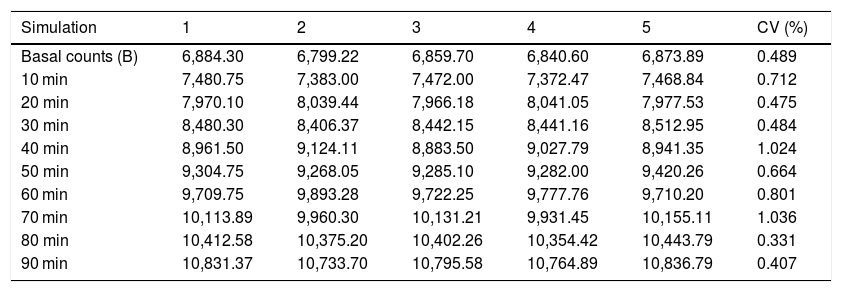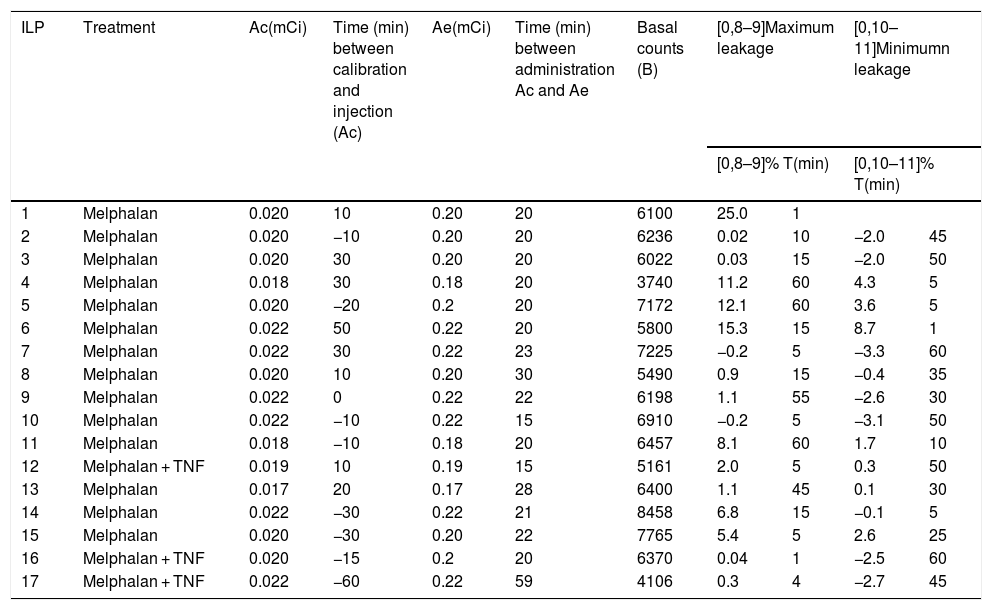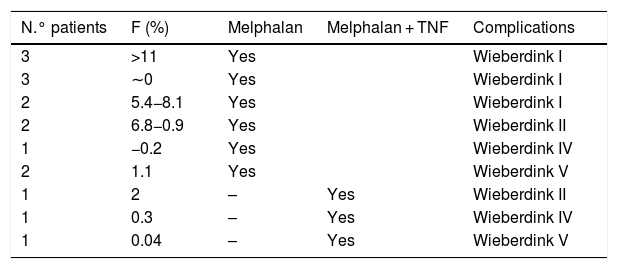Isolated limb perfusion (ILP) is a method for treating unresectable lesions of limbs in patients with melanoma or sarcoma by using high doses of tumor necrosis factor alpha and melphalan. This high doses can result in high systemic toxicity if there is a drug leak from the isolated circulation of the limb to the systemic. This makes it imperative to monitor the leakage rate (F(%)) during the infusion, currently performed with radiotracers. The objective of this work was to develop a leakage monitoring protocol as accurate as possible to ensure safe ILP.
Material and methodWe built a phantom with three compartments (body, limb and precordial area) and a high sensitivity collimator fitted to a portable gamma camera. We simulate ILP with scheduled leaks every 10 min from 1% to 9% (theorical F(%)). We mesured F(%) using two equation: one is the proposed in the literature and another corrected by decay of the radioisotope. We test the optimal radiopharmaceutical doses to minimize the detector dead time error and compare F(%) mesured by both equations regarding the theoretical F(%).
The leakage monitoring protocol was used in 17 ILP of 16 patients and an analysis of the recorded data was performed.
ResultsWe found significant differences between F(%) mesured using the first equation and theoretical F(%), obtaining results very adjusted to the theorical after applying the decay correction.
Conclusionsthe decay correction of the radioisotope is a simple manner to carry out the procedure more safely, reducing the error in the calculation of F(%).
La perfusión de miembro aislado (PMA) es un método para tratamiento de extremidades con lesiones irresecables de pacientes con melanoma o sarcoma. Se usan altas dosis de factor de necrosis tumoral alfa y melfalán que pueden provocar toxicidad sistémica severa en caso de fuga del fármaco desde la circulación aislada de la extremidad a la sistémica. Esto hace imperativo monitorizar el porcentaje de fuga (F(%)) durante la perfusión, actualmente realizado con radiotrazadores. El objetivo de este trabajo fue elaborar un protocolo de monitorización de fuga lo más exacto posible que garantizara PMA seguras.
Material y métodoConstruimos un fantoma con tres compartimentos (cuerpo, extremidad y área precordial) y un colimador de alta sensibilidad adaptable a una gammacámara portátil. Simulamos PMA con fugas programadas cada 10 minutos del 1% al 9% (F(%) teóricos). Medimos estos F(%) mediante dos ecuaciones: una propuesta en la literatura y otra corregida por decay del radioisótopo. Testamos las dosis de radiofármaco óptimas para minimizar el error por tiempo muerto del detector y comparamos los F(%) medidos según las dos ecuaciones con los F(%) teóricos. El protocolo de monitorización de fuga se utilizó en 17 PMA de 16 pacientes realizándose un análisis de los datos registrados.
ResultadosEncontramos diferencias significativas entre los F(%) medidos con la primera ecuación y los F(%) teóricos, obteniéndose resultados muy ajustados a los teóricos al aplicar la corrección por decay.
ConclusionesLa corrección por decay del radioisótopo es una manera simple de realizar el procedimiento de forma más segura disminuyendo el error en el cálculo de F(%).
Article
If you experience access problems, you can contact the SEMNIM Technical Secretariat by email at secretaria.tecnica@semnim.es or by phone at +34 619 594 780.

Revista Española de Medicina Nuclear e Imagen Molecular (English Edition)















